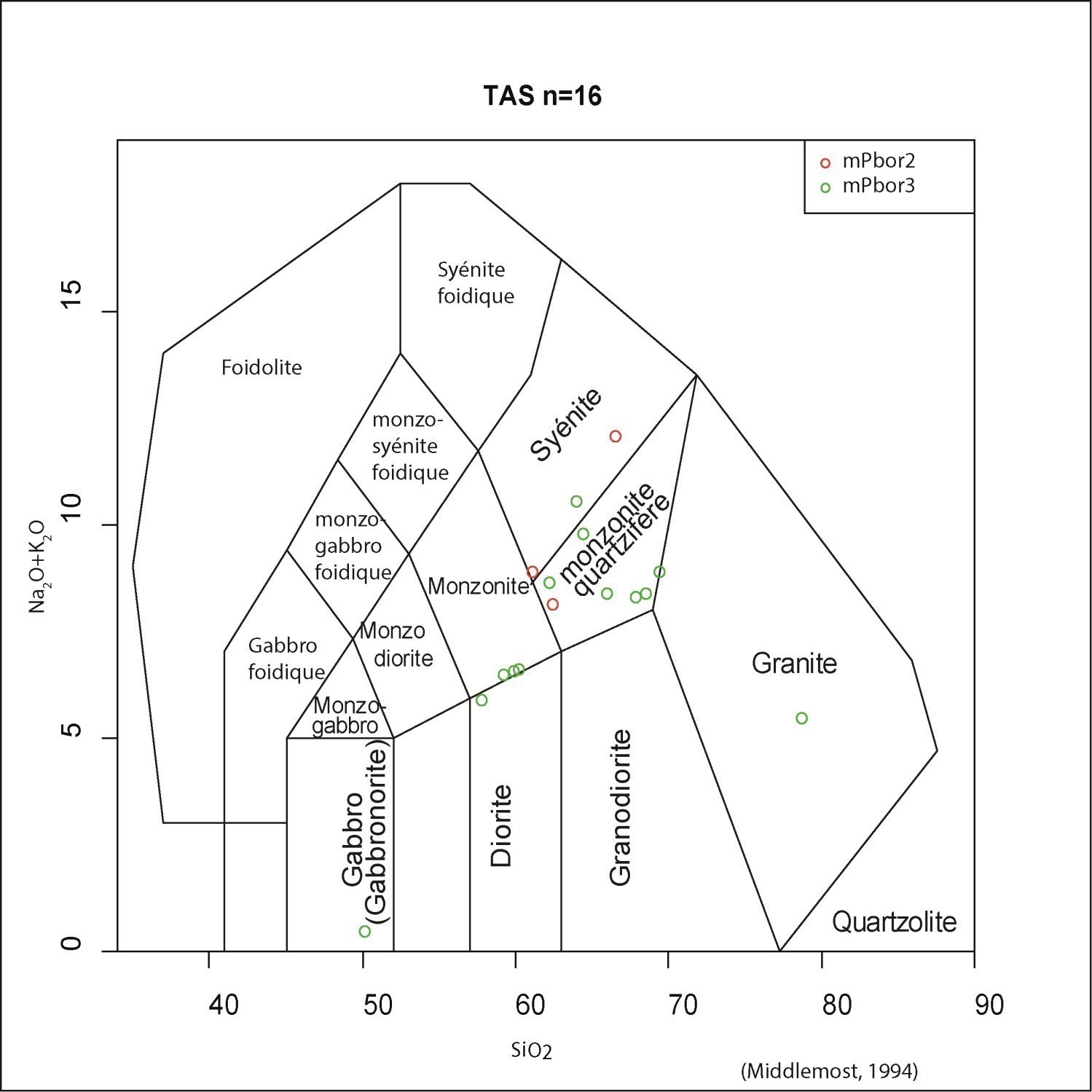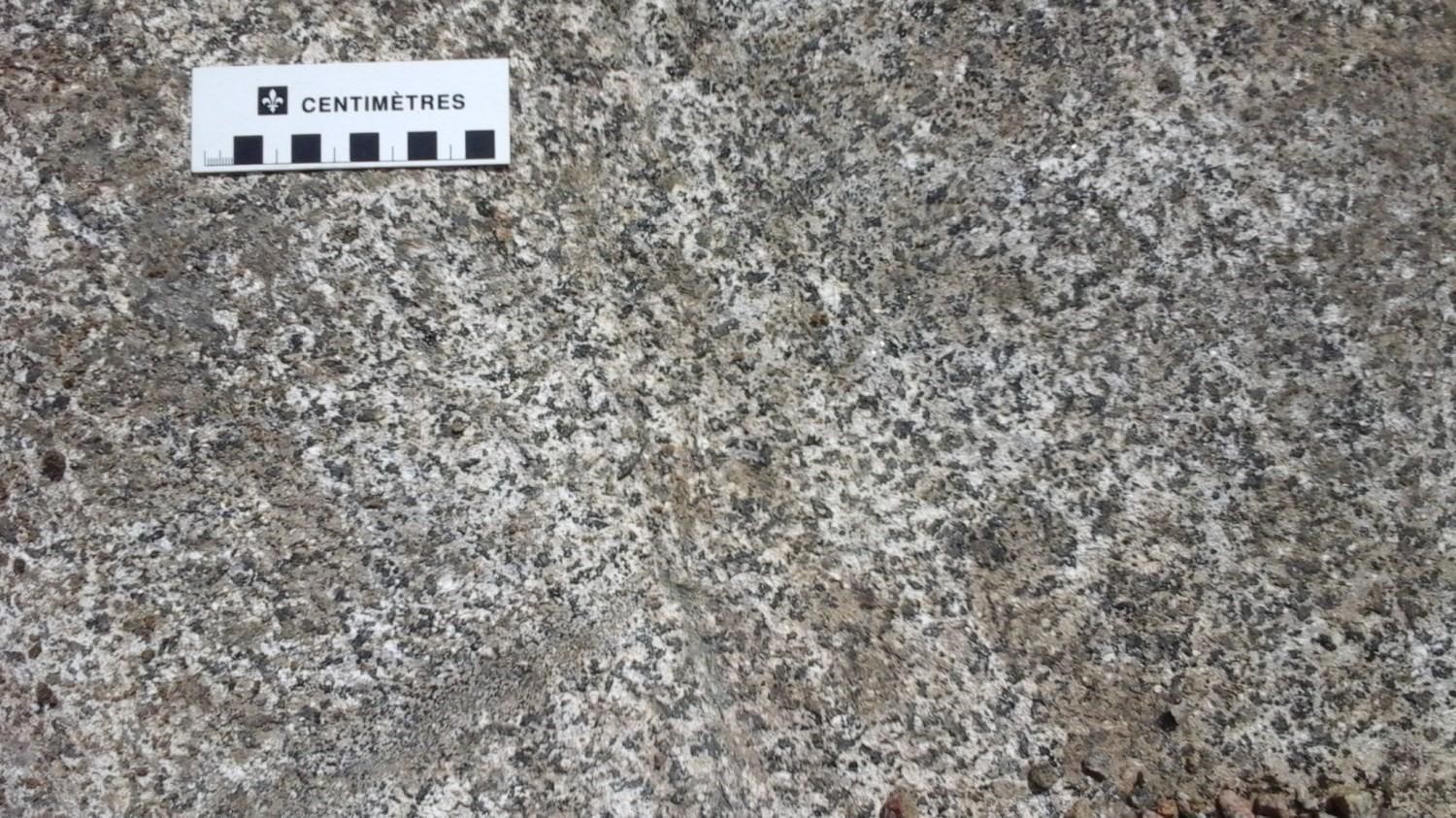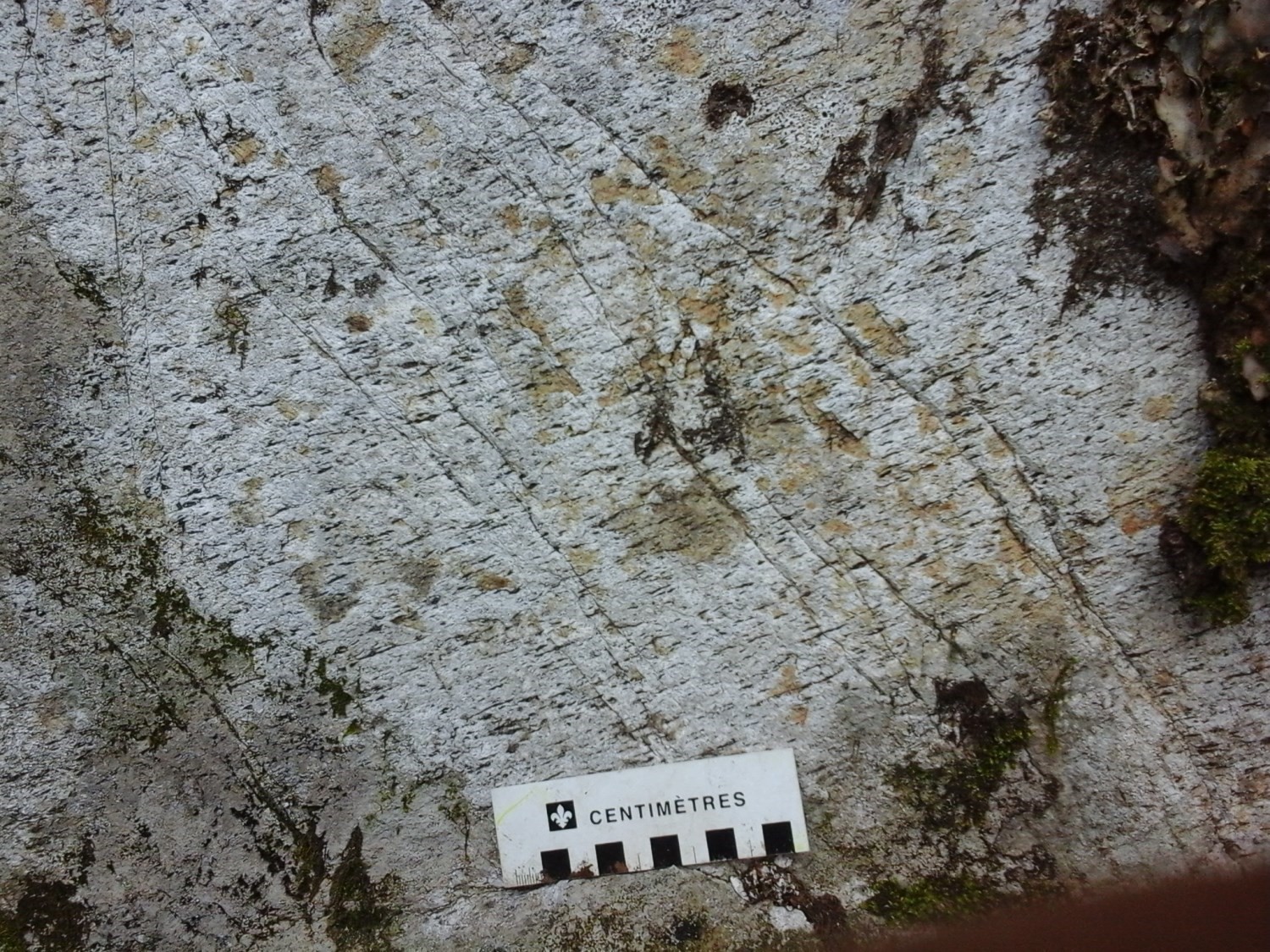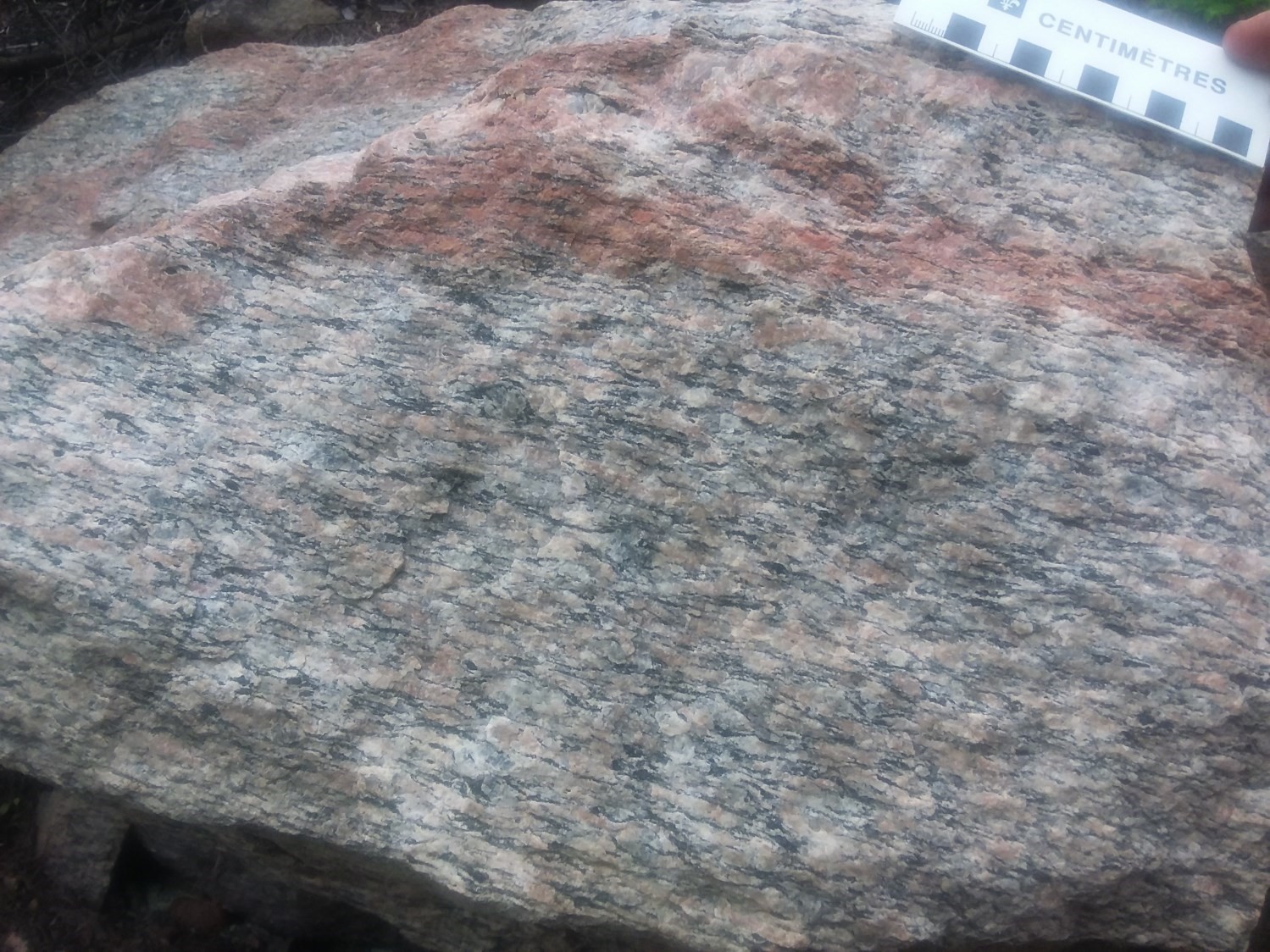
Last modified:
Translation of original French
| Author: | Perreault, 1992 |
| Age: | Mesoproterozoic |
| Reference section: | Outcrop 17-AM-61 |
| Type area: | Haut-Saint-Maurice (NTS sheets 31P16 and 31P15) |
| Geological province: | Grenville Province |
| Geological subdivision: | Allochton |
| Lithology: | Intermediate to felsic intrusive rocks |
| Type: | Lithodemic |
| Rank: | Suite |
| Status: | Formal |
| Use: | Active |
None
Background
The Borgia Suite was introduced by Perreault (1992) during geological mapping of NTS sheet 31P16 (Gand lac Borgia region). He then subdivided it into two separate units, mPbor1 and mPbor2. Moukhsil and Côté (2018) revised the boundaries of the suite and added a third unit (mPbor3).
Description
Borgia Suite 1 (mPbor1): Monzonite, Mangerite, Syenite, Syenogranite
Unit mPbor1 is composed of brownish to pinkish monzonite, locally K-feldspar and plagioclase porphyritic. It contains hornblende, biotite and locally orthopyroxene relics. Monzonite gradually gives way to pink granite. Mangerite, syenite, K-feldspar syenite and syenogranite are also recognized in this unit. These lithologies, massive to gneissic, are usually medium grained and contain hornblende and biotite.
Borgia Suite 2 (mPbor2): Granite, Mangerite, Syenogranite, Charnockite, Monzonite, Mafic and Ultramafic Boudins
Unit mPbor2 is polyphase, consisting of several lithologies of intermediate to felsic composition (granite, mangerite, syenogranite, charnockite and monzonite). Also, mafic (gabbro and gabbronorite) and ultramafic (pyroxenite, glimmerite) boudins were mapped. Granite is massive, medium to coarse grained and has a low magnetic susceptibility. Under the microscope, granite has large quartz zones with undulatory extinction, small biotite flakes, and K-feldspar and plagioclase. Syenogranite has a porphyritic and locally mylonitic texture. It contains plagioclase and K-feldspar phenocrystals, both sericitized. The unit is also composed of hornblende associated with biotite (locally altered to muscovite), opaque minerals (magnetite ± pyrite), trace orthopyroxene (charnockite) and quartz or feldspar intergrowths (myrmekite).
Mangerite is generally coarse grained and contains orthopyroxene, clinopyroxene, feldspar, magnetite, plagioclase, local myrmekite, in addition to green hornblende and biotite. The latter two are generally observed in association, and opaque minerals (magnetite) are visible locally. Some euhedral apatite crystals are observed in biotite. Mangerite contains trace titanite, while ilmenite and hematite are normative. Monzonite has the same composition as mangerite. Edge facies of unit mPbor2 show high magnetic susceptibility and magnetite is surrounded by carbonate minerals (supergene alteration).
Borgia Suite 3 (mPbor3): Syenite, Mangerite, Minor Amounts of Charnockite and Syenogranite
Unit mPbor3 is characterized primarily by syenite, with or without orthopyroxene, and mangerite. Syenogranite, with or without orthopyroxene, is mapped in places. The unit is also characterized by the strong magnetic susceptibility of its magnetite facies. It also includes minor amounts of granite and monzonite.
This unit is recognized by the pinkish to reddish alteration patina, and by hematitized and epidotized rocks. Located on the edge of Route 155 in the Lake du Chien region (sheet 31P16), this alteration zone extends on surface for a distance of approximately 6 km and a width of approximately 500 m. Rocks have granite composition with crushing of primary minerals (plagioclase, hornblende, K-feldspar, biotite), which are altered to epidote, chlorite, magnetite and trace carbonates. This alteration is pervasive in the rock, but is also located in joints. Epidotization is concentrated along fractures, and 5% of magnetite is visible in small interstitial crystals around K-feldspar. In these alteration zones, feldspars are sericitized. When rock is deformed, quartz crystals are very elongated and plagioclase crystals are crushed.
Unaltered syenitic facies are perthitic feldspar (Na and K) porphyritic, with or without orthopyroxene, and contain hornblende, biotite and large quartz zones with weak undulatory extinction. Locally, syenite contains euhedral hornblende that is systematically associated with biotite. Biotite flakes are also found disseminated. Mangerite is feldspar porphyritic and contains ferromagnesian minerals (green hornblende and biotite). Accessory minerals are apatite and zircon.

 From a geochemical perspective, rocks of this suite have SiO2 contents ranging from 48 to 77%. The Borgia Suite is gabbronoritic to syenitic according to the TAS diagram (Middlemost, 1994). In addition, it is predominantly metaluminous and type I.
From a geochemical perspective, rocks of this suite have SiO2 contents ranging from 48 to 77%. The Borgia Suite is gabbronoritic to syenitic according to the TAS diagram (Middlemost, 1994). In addition, it is predominantly metaluminous and type I.
Thickness and distribution
The Borgia Suite mostly outcrops in the centre part of a rectangle consisting of NTS sheets 31P09, 31P10, 31P15 and 31P16.
Dating
None.
Stratigraphic Relationship(s)
Unit mPbor2 is host of the Langelier Anorthosite, while unit mPbor3 overthrusts it. The Borgia Suite is also cut by granitic pegmatite dykes.
Paleontology
Does not apply.
References
| Author(s) | Title | Year of Publication | Hyperlink (EXAMINE or Other) |
|---|---|---|---|
| MIDDLEMOST, E.A.K. | Naming materials in the magma/igneous rock system. Earth Science Reviews; volume 37, pages 215–224. | 1994 | Source |
| PERREAULT, S. | Géologie du Grand lac Bostonnais. Ministère des Ressources naturelles et de la Faune, Québec; CG SIGÉOM31P, 1 map. | 1992 | CG SIGEOM31P |
| MOUKHSIL, A. – CÔTÉ, G. | Géologie de la région du lac Borgia, Province de Grenville, nord de La Tuque, régions de la Mauricie et du Saguenay – Lac-Saint-Jean. Ministère de l’Énergie et des Ressources naturelles, Québec. | 2018 | Bulletin géologiQUE |




